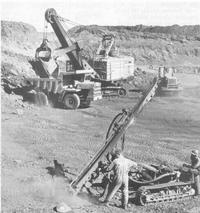


Chapter 10
I 1. Introduction
II 2. The Role Of Technology
III 3. Some Highlights Of Australian Minerals Technology
i Gold
ii Copper
iii Lead-zinc-silver
iv Technology in iron ore mining
v Iron and steel technology
vi Nickel
vii Mineral sands
viii Bauxite, alumina, aluminium
IV 4. Other Technological Achievements (in brief)
V 5. Export Of Technology
VI 6. Education And Research
VII 7. The Scientific Societies
VIII 8. Conclusion
References
Index
Search
Help
Contact us

Technology in iron ore mining
IntroductionAlthough some low grade ore provided feed for Australia's first blast furnace at Mittagong (NSW) as early as 1848 high grade iron ore mining did not commence (in South Australia's Middleback Range) until about 1900. This was used initially as flux for the lead smelters at Port Pirie but ultimately became the raw material for the BHP iron and steel industry which commenced in 1915 at Newcastle. In other areas throughout Australia large high grade deposits of iron remained relatively unknown.
In the late 1950s/early 1960s, however, as industrial nations entered an unprecendented growth phase there was a rapid increase in world-wide demand for high grade iron ore.
This, associated with the removal in 1960 of an embargo on iron ore exports from Australia, triggered dramatic exploration activity by large companies particularly in the Pilbara region of WA. Major discoveries of high grade ore resulted, and by 1969 three large scale export projects had commenced production: Goldsworthy, Hamersley and Newman.
Expansions followed at these mines together with new developments at Robe River and Paraburdoo in the early 1970s. The Pilbara is now Australia's major source of iron ore.
The projects, financed and built entirely by private enterprise, involved the design and construction of new mines, product treatment plants, pellet plants and associated infrastructure including townships, railways and port facilities on a scale equal to the world's largest. These were remarkable achievements considering the remote locations, the adverse climatic conditions and the almost complete absence of population and infrastructure within hundreds of kilometres.
It was a period of sustained growth in world demand for steel and consequently iron ore. For example, Japanese crude steel production increased from 41 Mt in 1965 to 119 Mt in 1973 with iron ore imports rising from 39 Mt/a to 135 Mt/a. This in part supported the rapid development of Australian exports from virtually zero in 1965 to more than 80 Mt/a in 1974.
Geological background
The Proterozoic occurrences of iron ore in Australia include the Middleback Range in South Australia, Yampi Sound in north-west WA and the major Hamersley Iron Province in the Pilbara Region of WA. This is an 80,000 km2 sedimentary basin which contains in its structure two Banded Iron Formations, the Brockman Iron Formation (670 m thick) and the Marra Mamba Formation (180 m thick) which are host to economic deposits of iron ore. These occurrences have been succinctly described as strata bound sediment hosted deposits.

The Province also contains a number of Tertiary Age pisolitic limonite deposits of considerable significance. They have resulted from deposition in ancient drainage channels of weathering products of the outcropping primary ore.
More than 33 billion tonnes of iron ore with a grade in excess of 55 per cent Fe have been proven in the Pilbara region comprised mostly of hematite and hematitegeothite ores but with some major occurrences of limonite.
Organisations in Australian Science at Work - Mount Isa Mines (M.I.M.)
 |
Australian Academy of Technological Sciences and Engineering |  |
© 1988 Print Edition pages 752 - 753, Online Edition 2000
Published by Australian Science and Technology Heritage Centre, using the Web Academic Resource Publisher
http://www.austehc.unimelb.edu.au/tia/717.html